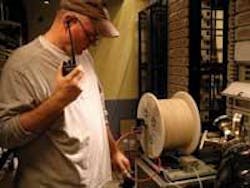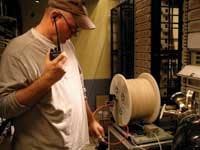Weighing MMF vs. SMF in premises applications
Standardized in 2002, laser-optimized 50-µm multimode fiber (MMF) was designed to provide quantifiable advantages in 10-Gbit/sec premises-cabling applications. However, singlemode fiber (SMF) has seen an increase in premises network deployments, leading some industry insiders to speculate that SMF may be encroaching on the “sweet spot” for MMF. Moreover, some network installers may be waiting for the maturation of 10GBase-T copper technology to avoid the migration to fiber altogether.
Today’s enterprise networks must support high-bandwidth, low-latency, high-speed applications like voice-over-Internet-Protocol (VoIP), IP video, and IP-based security, leading network installers to upgrade to 10-Gbit/sec transmission speeds. According to Kurt Templeman, product manager of enterprise networks at Sumitomo Electric Lightwave (Research Triangle Park, NC), 10-Gbit/sec 300-m link lengths remain the application “sweet spot” for MMF. “Certainly over the last couple of years, we’ve seen more and more singlemode in the enterprise network than we’ve ever seen before,” he admits, “but I don’t know that it’s necessarily encroaching on the laser-optimized world.”
An increase in SMF deployments in the premises usually accompanies an upgrade in Ethernet speeds, adds Michael Connaughton, director of sales and marketing at Mohawk/CDT (Leominster, MA). “There is a segment of the customer base that is going to [deploy singlemode] as an insurance policy, people who are going to say, ‘With the multimode I’m deploying, how much longer is it going to last?’” he explains. “Singlemode is brought in as an insurance policy. Certainly from a technology standpoint, singlemode will last longer.”
Templeman and Connaughton agree that the split is probably 60:40, MMF to SMF in the premises. SMF primarily is deployed in campus backbone environments, where installers are opting for low-water-peak versions, and for link lengths longer than 550 m. Laser-optimized 50-µm MMF, meanwhile, continues to find traction in new builds and upgrades with link lengths shorter than 300 m. But for link lengths between 300 m and 550 m, fiber choice is not so obvious.
For their part, the fiber manufacturers are bullish on MMF, which they claim results in a more efficient network. For example, the core of MMF is five times larger in diameter than that of SMF, leading to lower-loss connections and improved fiber-to-fiber or fiber-to-transceiver alignments. According to David Velasquez, global product line manager of singlemode and premises fibers at Corning (Corning, NY), the 10% lateral offset or coupling inefficiency of MMF results in a 0.6-dB loss. But for SMF, that lateral offset is closer to 70%, causing a 5-dB connection loss.Moreover, because the core of an MMF is so much larger, it is less likely to suffer negative effects from dust particles on the fiber or connector assembly. A dust particle with a 4-µm radius can block more than 80% of the received power in an SMF, says Velasquez, but have a negligible impact on MMF, leading to greater field reliability.
There are also significant economic benefits to the deployment of MMF. When you consider the passive plant itself, including the fiber and equipment that connects the fiber to the switches and closets, SMF cables are less expensive than their MMF counterparts. MMF is more expensive due to more expensive raw materials and more complex manufacturing processes.
Though MMF itself is more expensive, it enables the use of less-expensive light sources, including 850-nm vertical-cavity surface-emitting lasers, versus the more expensive Fabry Perot or distributed-feedback lasers used with SMF. “As an end user or contractor, you have two choices,” notes Velasquez. “You can use a cheaper fiber with more expensive lasers, or you can use a more expensive fiber with cheaper lasers.”
At the end of the day, MMF is the more economical choice, says Connaughton, because the laser is the most expensive component of the optical link. The fiber and associated connectivity account for just 5% to 10% of the total link cost. “Cable for cable, maybe you’re paying twice as much for the multimode,” he says, “but when you add the active portion of the network on top of that, any savings that were garnered by going singlemode are washed away.”
Despite the cost premium associated with SMF electronics, there are a few reasons why a network installer might deploy SMF in the premises-beyond the need for longer link lengths. SMF appeals to network installers who have a definite future need for higher bandwidth, says Connaughton. Often, people will install both in the form of a hybrid SMF/MMF cable or as two separate fibers deployed in parallel.
“For folks who are thinking about 40 Gig or 100 Gig, there is no standard yet for multimode,” adds Velasquez. Most fiber manufacturers have designed their MMF cables to support those speeds, but the premises-cabling market is generally standards-driven. Network installers prefer to have standards in hand before they embark on a major deployment and will opt for SMF as insurance for the future.
Others may opt for SMF simply because it reduces complexity. “There are those customers who say, ‘Look, I’m tired of all this singlemode, multimode, 62.5-µm, 50-µm, laser-optimized. I’m putting everything in singlemode and I’m done with it,’” says Templeman.
That familiarity may prompt some network installers to wait for approval of the forthcoming 10GBase-T copper standard. There is a key advantage to deploying copper: It doesn’t require a laser. Any fiber-based cable is going to require a transceiver, which adds to the network’s complexity-and is another potential source of failure. Network managers also must keep transceiver spares in inventory.
That said, “A copper-based solution that works at 10 Gbits/sec is not going to be your father’s simple copper solution,” cautions Velasquez. The more advanced copper cables, including Category 6E and 7, are bigger and heavier, require more power, and are significantly more complicated to test and terminate in the field. Even the cost savings you might achieve deploying copper over fiber are a wash when you compare the cost of fiber versus higher-speed copper cables, adds Velasquez.
The fiber manufacturers have heard the copper versus fiber argument for many different applications. Templeman says, “You are still going to have an enormous number of people in the fiber-to-the-desk-type arena, for example, who are just going to stay copper because it’s something they understand. There are some cost benefits to that, but they aren’t nearly as big as they used to be.”
For his part, Connaughton believes the ratification of the 10GBase-T copper standard should drive fiber deployments. “If the market views 10-gig as necessary in the horizontal, that’s going to drive bandwidth demand in the backbone,” he reasons. “Once the 10-gig standard is released in a few months, there’s going to be a splash about it, and we’ll start seeing more activity in the fiber portion of the business.”
